April is national soyfoods month in America. Seriously. Every month of the year has been snapped up by at least one food group or industry. Why not soy in April?(!) Given that, I wanted to address a couple of common misperceptions about tofu.
First off, I'm an omnivore. My new book, Asian Tofu, isn’t a vegetarian cookbook or one that aims to preach and convert. It’s about showcasing tofu as a delicious food with borderless Asian roots.
Nevertheless, a handful of people have asked me about tofu’s impact on personal health. I'm not a health expert and often end up engaging people in conversations about what tofu is and what it's not. Below are a couple of recurring topics and a recap of my responses. Feel free to weigh in.
Is tofu a processed food?
The answer depends on how you define a processed food. Most of us think of processed foods as something that’s been altered from its natural/original state, mostly for convenience or safety reasons. It’s been stripped of its essence. It’s a non-food or food-like substance. It’s packaged in cans, frozen, dehydrated, refrigerated and has gone through some kind of aseptic processing so that it can have a longer than freshly made shelf-life.
If you survey the various kinds of tofu sold at an Asian market, you’ll see it as a food that can be:
- frozen (sponge-like for sucking up seasonings and broth)
- dried (gossamer and great for dumpling wrappers, soup, sautes)
- freeze dried (lightweight and terrific for long-term storage)
- refrigerated (the ubiquitous blocks, fried pieces, noodle-like strips, pressed and baked, etc.)
- jarred (fermented, preserved, and full of umami)
- canned (pouches for inari zushi, a supermarket mainstay)
- boxed (for travel or emergencies only, please!)
In terms of how tofu can be commercially sold, yeah, it’s technically a processed food. Here a few ways that tofu can be packaged:
Aside from being a packaged product, tofu is also a processed food in the sense that it typically involves rendering soy milk from soybeans and water and then coagulating it to separate the curds and whey. Mold and press on the curds to make block tofu.
Indeed, there is a process involved, but the pertinent question is: How removed is tofu from the dried soybeans that it’s based upon?
Not much. The kinds of tofu described in the bulleted list above are minimally processed foods.
Next time you shop for tofu, check out the ingredient label. It's probably not very complex. Common coagulants include: calcium sulfate (gypsum), magnesium chloride (nigari), and delta glucono lactone (GDL). In the case of tofu skin, there's often a preservative involved. Then there are soybeans, water, and maybe seasonings depending on the type of tofu. There shouldn’t be too many strange sounding ingredients on the labels. If you’re really into exploring tofu, make some from scratch to understand how it comes together.
Another type of processing that Asian tofu goes through yields mock meats, though Tofurkey and Soyrizo are not among them. During my tofu research time in Taipei, I saw chicken molded from tofu and tasted this darn convincing tofu pork belly:
Some people enjoy meat analogs fabricated from tofu but I see them as overly tricked out Franken-tofu that are a bit too far removed from tofu. They're fun to sample but don't seem like food I'd want to eat often.
On the other hand, Asian cooks do have straightforward ways to use tofu to create interesting mock meats. For example, below is unagi modoki (fake tofu eel) that I craft from mashed tofu:
I start with tofu, mash it up, then sculpt it to look like eel. Finally, I cook and garnish it to replicate the real deal. You could make splendid sushi with this tofu eel. (For the recipe, see the Mock Meats chapter, page 157, of Asian Tofu.)
Can eating too much tofu be bad for you?
I ate a lot of tofu on a regular basis while writing the book. One discovery that I made was this: It’s really hard to eat a lot of tofu in one sitting. Tofu is a very filling, satisfying food. In fact, after we filmed TastingTable.com’s tofu tasting bar video, the crew and I couldn’t finish all of the tofu, despite being famished at the outset. You can only eat so much tofu before you feel full.
Of course, people who suffer soy allergies should definitely stay away from tofu. If that’s not your problem, and you want to have soy in your diet, note that foods containing soy-derived ingredients are not the same as tofu.
For example, eating a soy-laden protein bar is not like eating a block of tofu. Check the protein count on the energy bar and compare that to how much tofu you have to eat to get the same amount of protein. It’s typically a sizable quantity of soy-derived protein that’s been added to the bar. On a tofu label such as this one, the serving size is generally 3 ounces:
What’s more, if such kinds of soy-rich products are a major part of your diet, you may overload the body with soy. Extreme eating of anything may cause your body to negatively react.
In 2009, Men's Health magazine ran a lengthy story on soy's potentially negative effects. Among the cases featured, a man developed enlarged breasts ("man boobs") as a result of drinking 3 quarts of soy milk a day. Erectile dysfunction, high estrogen levels, and dementia were also mentioned as perhaps resulting from over consumption of soy. The takeaway was this quote:
For his part, Dr. Lewi believes that soy products in moderation can still be a healthy part of a man's diet. "The problem," he says, "is when a thing like soy is touted as this wonderful panacea for health, and people end up going overboard on it."
This past March, the Harvard study on eating red meat got a lot of people running for their vegetable and bulk bins. I poked around the Harvard School of Public Health website and found an article on smart approaches to choosing protein for your diet.
The bottom line is that there is no magic bullet, one-size-fits all approach to healthy eating. With regard to soy, all the claims about the health benefits of eating lots of soy – from lowering cholesterol and mitigating hot flashes to preventing breast and prostate cancer, helping weight loss, and preventing osteoporosis – are inconclusive. So are the claims against eating soy. What's a health-conscious person to do?
This nugget of advice came at the bottom of the ”Straight Talk about Soy” section:
Eat soy in moderation. Soybeans, tofu, and other soy-based foods are an excellent alternative to red meat. In some cultures, tofu and soy foods are a protein staple, and we don’t suggest any change. But if you haven't grown up eating lots of soy, there's no reason to go overboard: Two to 4 servings a week is a good target; eating more than that likely won't offer any health benefits and we can’t be sure that there is no harm.
So unless you have a bad reaction to soy, go ahead and enjoy tofu once or twice a week. Fry tofu, if you want; that's what many Asian cooks do. Have it as a savory or sweet, with meat or without, as part of a varied diet with lots of vegetables, legumes, grains, and fruit.
Finally, if you're eating tofu because it's suppose to be healthy but you don't really like its taste, maybe you should try new ways to prepare it. If that doesn't work, tofu may not be for you.
Healthy eating should not be about deprivation. If tofu is part of your diet, it should be a delicious food to you, not a denial food. Life is too short.
Got a question about tofu or soy? Let me know and I’ll try to answer it.
Related post: A video guide to tofu textures and sample tofu recipes from Asian Tofu.













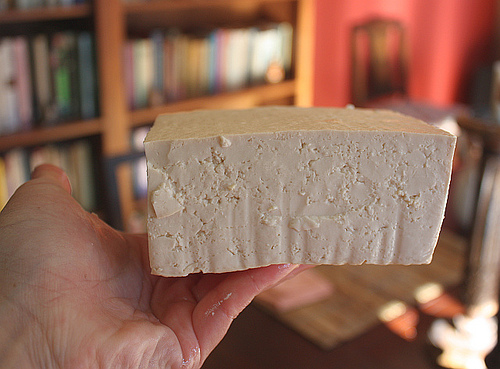
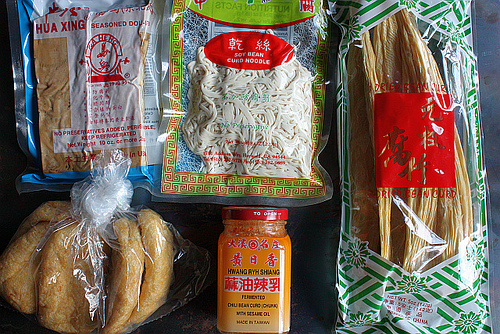
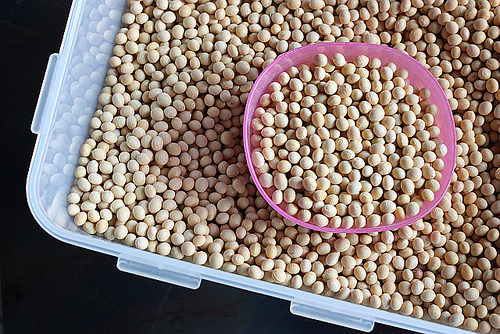
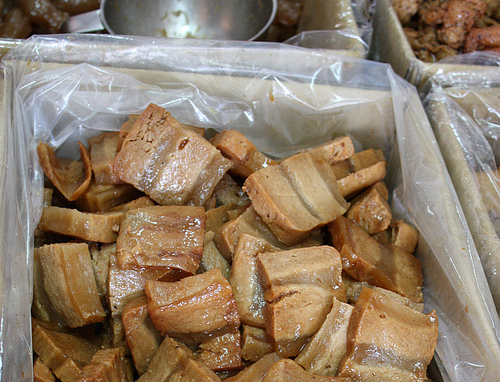
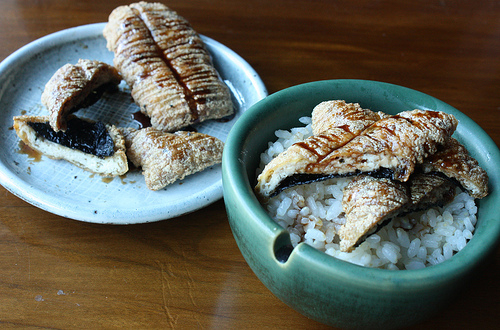
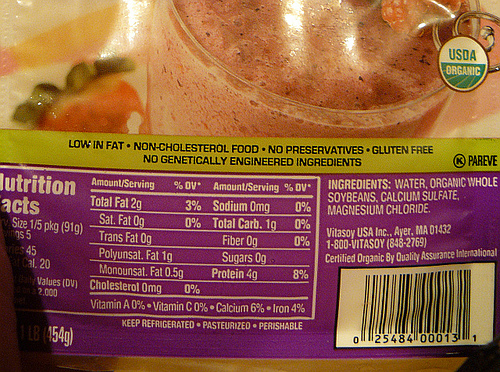




Eve says
Moderation in all things, and a little bit of what you fancy does you good.
I'm dying to know how they make the translucent "fat" on the mock pork belly. It looks so much like the real thing!
Katie says
Tofu has actually ended up helping my moods even out. It's probably only a reaction that I'm going to have and it may even be a placebo effect for all I know, but one week a month really helps my mindset.
I really don't like soy based meat replacements. I haven't had a commercially prepared one that appeals to me.
Andrea Nguyen says
I'm with you, sister -- on moderation and on how the heck did they produce that fake fat? I do not know and the gals who gave me the sample didn't either. I imagine that it's some kind of starch or flour.
Andrea Nguyen says
It's great to hear that tofu has a positive impact on your mood. It may be comforting but maybe that extra bit of estrogen helps to even out the edges. Sounds like you monitor your system well and that's important.
Eve says
Yes, maybe something like konnyaku or tapioca pearls. In any case, it's very cleverly done although I doubt I'd eat it on a regular basis.
Dave Lieberman says
Could it be konnyaku?
Lynne says
Andrea, it's so refreshing to read your intelligent take on the soy controversy! My thought has always been - when told that tofu isn't good for me to eat, I think about all who are Asian & have eaten it all their lives!!
Moderation is so important, and I SO agree with your explanation about the difference between tofu and the processed soy products that have flooded the U.S. market. THANK YOU!!!
Andrea Nguyen says
It could have been konnyaku, Dave, but it wasn't super chewy like the candies sold at Asian markets. When I bit into it, it was surprisingly tender. ^_^
Andrea Nguyen says
Lynne,
This was a tough post to write because the subject is so loaded and polarizing. However, when I had to talk to people publicly about it, I realized that tofu was being lumped into a broader category of soy-based convenience foods.
Add to those misconceptions is the desire for an easy solution to good health. Taking a pill or consuming massive quantities of one particular food can't be a viable option. We have to think about what healthy eating is and figure out a balanced diet for ourselves.
Tamara says
I us to eat soy, loved the flavors and versatility but after learning that 90% of soy crops planted are now GMO (genetically modified)I have stopped using it. Here's a chart showing the percentage planted. http://www.ers.usda.gov/Data/BiotechCrops/
Really a shame how Monsanto is destroying our food.
L says
Tamara, It's definitely possible to buy organic non-gmo tofu and soy products. Or make your own as I plan to try doing once I get Andrea's book. :O)
Andrea Nguyen says
Well, that's is very true but it's also because most of the soybean crops in the US goes for industrial or agricultural use. Very little is grown for human consumption. Most of it is for animal feed.
You can definitely get non-GMO or organic tofu products, like L says. In fact, the Nasoya label in the post is made with certified organic beans. The soybeans pictured in the post are non-GMO and come from a single source farm in Iowa.
Here in California, there's organic tofu at Safeway supermarket. Whole Foods and Trader Joe's are excellent sources for organic tofu at reasonable prices. Asian markets are carrying more non-GMO tofu too.
Don't give up on soy. Just look for the good stuff!
Yun Ho says
The controversy around the safety of GMO products will continue to exist for years to come and even if we make best efforts to avoid GMO products, we would be exposed to them one way or another without realizing it.
Last September in Hong Kong, Hong Kong Consumer Committee tested 50 soy drinks and found 50% of the products contained GMO soys. Even some "organic" soy drinks contained GMO soys...
Most of imported corns and soy beans used to make corn by-products (corn oil,corn syrups, etc...) and soy products (like Tofu and soy drinks) in Korea were GMO products and they are mainly from the States.
The only viable answer - Que sera sera...I have yet to hear that eating soy food as the main cause of death!
[email protected] says
I have friends with thyroid disorders who've have strong negative reactions to soy, so tofu is out for them. I think people with compromised immune systems or people who're experiencing some kind of symptom that may be food base, should check if soy is a problem for them. Knowing this, I eat soy sparingly, but I eat everything sparingly other than raw or steamed vegetables and fruit. Everything else is what I eat in moderation. 🙂
jorgebob28 says
I don't if it's true but I've heard that the soybeans used for tofu are a different variety than the GMO strain. Just to be safe, I buy organic tofu. I'm not sure if eating large amounts of tofu is detrimental as suggested. I'm from Okinawa and tofu is eaten daily in compressed and free-floating curd forms and we've all heard of the longevity (not as long-lived as before, however) and mental acuity of old people there. My grandma lived 'til 99 and many others in her village on Kume Island lived beyond that.
Due to the clean seawater, Okinawan tofu is made with nigari instead of calcium sulphate.
maggie says
Another pertinent question would be "Are the soybeans used to manufacture tofu genetically modified?" It may traditionally have been a health enhancing component of Asian diets (particularly as a source of protein), but I would not make that assertion in view of modern production methods. Tofu is versatile and delicious, so I would experiment with the many ways to prepare it if you enjoy the taste. However, I would not regard it as a health food in any way. On the subject of soya, I have noticed among my acquaintances a link between peanut allergy and consumption of soya milk as an infant (often prescribed for children with allergy to cow's milk).
nike free running shoes says
Zeer goede site heb je hier, maar ik was nieuwsgierig naar als je wist van elke discussie borden die dezelfde thema's gesproken over hier te dekken? Ik zou heel graag een deel van de online community waar ik advies te krijgen van andere goed geïnformeerde mensen die dezelfde interesse delen zijn. Heeft u nog aanbevelingen, laat het me weten. Heel erg bedankt!
Barbara says
I like Trader Joes Organic Spouted Tofu. A 16 oz package is divided into 2 separated sealed containers. Great for singles and if you use it sparingly. I use it in my fab vegetarian lasagne without ricotta or mozarella. I'm not a vegetarian per se so I do used some parmesean on top.
StokeyBear says
mock meat weirds me out. I enjoy making unique tofu rather than buying chemically enhanced mock food. Since tofu is pretty much like a blank slate, it's so great custom making all my vegan treats. I actually really enjoy the taste of cooked tofu, and even raw isn't too bad.
PersonalShopperBangkok says
Hello,
Is tofu so difficult to find in the rest of the world ?
We are located in Thailand and have people asking to ship them tofu by Express mail !!!
How much does tofu cost where you live ?
Thank you.
Bangkok Personal Shopper
Martinschmidtinasia.wordpress.com says
Living in Hong Kong, I really enjoy tofu, but my health practitioner shared with me that soy protein isolate is one of the "9 Foods Never to Eat."
http://shine.yahoo.com/healthy-living/9-foods-never-eat-151600575.html
Soy protein isolate
There are two types of soy: whole soy - found in protein-packed edamame and soy nuts - and soy protein isolate, which the highly refined, nutrient-stripped product found in foods like tofu, soy "meats" such as tofurkey, and soy milk. With soy consumption already unhealthily high in America, it's best to choose alternatives like coconut or almond milk and tempeh.
Incidentally, I was in rural China last week (Yunnan Province) and had tofu in two dishes in a health-conscious hotel, and it tasted very different from HK tofu. It felt fuller and more nutritious, although it had a distinct "smoky" taste. I'm not sure if it was non-GM, but it was locally made. So, I'm wondering if tofu in China may in fact be non-GM, and secondly, if so, could it be that "real" (non-GM)tofu has a very different taste? You can see pictures of our trip on my blog: http://martinschmidtinasia.wordpress.com/2013/07/15/teaching-social-conscience-to-younger-children-micahs-experience-with-apple/ . I also highly recommend the Linden Centre where we stayed. There probably is no place in China that is trying to preserve local culture like the Linden Centre.
Richard Seeto says
I find it hard to believe that eating tofu is poisonous. Asians particularly the Chinese have been eating it for centuries and there are no adverse reports on its nutrition and Monks and Nuns eat the food for their mind-clearing. Now we have Western experts telling us that it is bad. Well, let your taste and life experience be the judge.
Andrea Nguyen says
Right on!
Surfdancer says
Oh my naive one....It used to be that way......long ago, before Monsanto dominated 90% of the soy market globally.
Different ball game today, Richard.
Andrea Nguyen says
Much of the commercially grown soybean goes toward oil production and livestock feed. There are thousands of kind of soybeans out there, bred for specific use.
Fortunately, nowadays, you can find tofu products that are made from good beans. For example, I use single sourced soybeans grown in Iowa by one family of farmers. The Chambers have been naturally breeding soybeans for generations. Because tofu relies upon soybeans, water and coagulant, choosing a good bean is key; that's part of making good, tasty tofu.
Yes, Monsanto has a lot of market share but there's wiggle room in the space it does not control. There's a lot of soybeans out there!
Sonia says
I eat tofu once a week as a meatless dinner and I love it. I looked up a recipe online called mushroom tofu stir fry and it’s absolutely delicious. Let me know if anyone is I nterested I’ll share the recipe
Andrea Nguyen says
Hooray!!! I'd love the recipe to try out so email it to me via the contact form: https://www.vietworldkitchen.com/contact
HX says
Hi Andrea,
I read the Men's Health article, and the man who developed "man boobs" drank 3 quarts of soymilk per DAY, not 3 quarts per WEEK as stated in your article. Please correct this. Thanks in advance!
Andrea Nguyen says
You're so right. I read that wrong, or maybe I was already shocked that someone would drink 3 quarts of soy milk per week! But per day!!! That's extreme. I made the edit and thank you for taking time to point this out, and watching my back!
jo mama says
that pic of the silken tofu u captioned"14+ grams of protien" and the pic literally saids 4 lol moron
Andrea Nguyen says
Please read more carefully. The caption says: "This is silken tofu, the softest kind. Super-firm typically has 14+ grams per 3 oz serving."
The 14 grams refers to super-firm tofu.